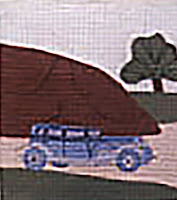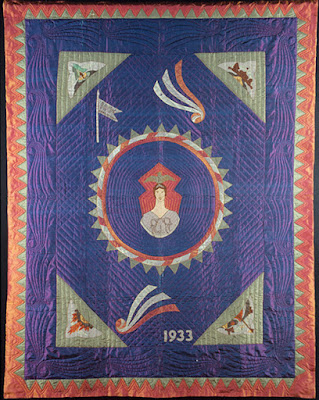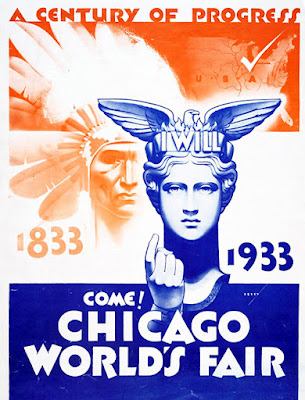Our book is way out-of-print but you can buy copies at the usual used book sites.
We are indignant about several things, mainly that the winner of the big prize did not put a stitch in the quilt. We discuss how Margaret Rogers Caden manipulated the rules in today's episode. Not only did she refuse to share credit with Ellen Mainous and the actual Kentucky stitchers, she did not share the cash.
We are also indignant about another outcome that we didn't have time to discuss much in the program. The many judges ignored the written rules.
Minneapolis store
The contest was set up as a series of regional finals at big Sears stores around the country. Prizes of about $200 were given for first place winners in the regionals.
Local judges awarded the lesser prizes.
Winners then went to Chicago, home of Sears & the fair, where a national first, second and third prize were awarded.
Their publicity department published the contest rules in February during the depths of the Great Depression, no doubt attracting the attention of many who would have made good use of that $1000 first prize. Many also noticed the bonus prize offered: An extra $200 "If the Grand National Prize Winner is an original design commemorating The Century of Progress."
Dora Hurless of Chicago used fair imagery on hers with the special Sears building in the center. The file on this mentions that blue ribbon attached to it as a first prize award, but it wasn't. A plethora of ribbons were awarded at all levels. The ribbon does tell us that Dora got this finished in three months and entered it at some level.
Sears, a big newspaper advertiser, used their influence to
obtain a lot of column inches in the spring of 1933.
Samantha Allison Wise
$1,200 was an enormous amount of money in 1933. You could buy 2 Ford sedans at $450 each and have $300 left over for a road trip to Chicago.
Despite the time constraints---they had 3 months to complete a commemorative quilt and get it to the contest---many, many people took up the challenge.
Chicago Historical Society
Kansas City Star, July 2, 1933
Ida Stow who made this quilt with the fair logo was herself indignant that she and her mother had worked all spring on a commemorative only to find the category ignored.
Perhaps in response to her complaint Sears showed a few of the commemoratives at the 1934 reprise of the fair with Ida's in a place of honor.
Helen Billick of Gary, Indiana was invited to show hers in 1934.
Quilters interpreted the call for imagery commemorating the Century of Progress exposition in a variety of ways but quite a few included an image of the Sears exhibit building at the fairgrounds.
Lora McKinley Montgomery of Fort Wayne, Indiana
Fort Wayne Museum
Detail of another Fort Wayne quilt, this one by mother & daughter team
Cathryn Elizabeth Wolford Burns Cowic & Mary Cecile Cowic Finton.
Rosetta Scott of Prescott, Arizona
I always say "It couldn't have hurt your chances to advertise
their building."
Anna Hansen's building features two modern modes
of transportation, an airplane and a dirigible. One
of the general fair themes was A Century of Progress in Transportation.
Unknown maker
Mississippi Heritage Museum
Mrs. Wardie Conner Hill, Falkner, Mississippi
Transportation: A topic Elizabeth Skelly Fitzgerald of Highland Falls,
New York covered thoroughly.
Photo from the Baltimore Sun archives showing a quilt
that must have been made on the theme of transportation progress
and also a Century of Progress in architecture.
Chicago Historical Society
Elizabeth Weigand, Muskegon, Michigan
Chicago's motto is "I will." Elizabeth put the "I Will Woman"
in the center of her satin quilt.
Another city image is the Y, representing the Chicago River, in the center of this wheel of progress.
Municipal building
Embroidered exhibit buildings
Sold at a Pook & Pook auction
International Quilt Museum
Emma Mae Leonhard of Virginia, Illinois quilted progress in transportation in the borders
and appliqued a Century of Progress in clothing fashion.
Chicago's history from its settlement by European-American culture in
1833 is also a theme. Here: Fort Dearborn the first outpost
in the center and the Great Chicago Fire to the right.
Mary O'Halloran Fitzgerald's Fort Dearborn
updated with a scalloped border and the newly popular Nile green.
Chicago Historical Society
Bertha Stenge, Chicago
Progress and a Peacock
Pearle Berton Konitzer, Appleton, Wisconsin
And then there is text...
Sometimes tricky to applique
Jeanette Morgan Longsworth, Racine, Ohio
You could use a pieced alphabet from the Ladies' Art Company catalog.
Richard & Lucille Rowley, Chicago
This aerial view of the fairgrounds now in the Boston Museum of Fine Arts
is traveling with their exhibit Fabric of a Nation.
Some people like the Rowleys were really good at this
and obviously should have won a cash prize.
Another husband/wife team Linda & Clarence Rebenstorff
of Stevens Point, Wisconsin did impressive portraits.
While others had more enthusiasm than drafting skills.
Zada Chapman, New Smyrna, Florida
Amelia Stram Greinger, Minnesota
Henry Ford Museum Collection
Zemma Haynes Taylor, Farmersville, Louisiana
Do go to Merikay's files at the Quilt Index, which include many
of these quilts.
Some pictures here I have found in auctions and others just
floating around the internet.
Olive Thomas Wetzel, Nashville, Illinois
And some are from our book, which still looks pretty good 30 years later.
The Quilt Alliance records their Textile Talks so if you miss it this afternoon you can watch it later.
Quilt Index but I can't find it again. Pioneer Days...Century of Progress
1849 to 1933???

















%20E%20garyIN.jpg)






































Wow. What a disappointment that contest was on so many levels. Not sharing the prize with those that made the winner. Judges ignoring the rules. The whole class of World's Fair theme quilts ignored (and IMHO those had the most imagination and work to make!).
ReplyDeleteThank you for the reminder about this book, and the link to the video.
The World's Fair Quilt by Jennifer Chiaverini is a wonder historial fiction book on the quilt contest.
ReplyDeleteAgree the Cheverini book is nice historical fiction about this ever!
Delete